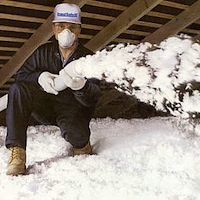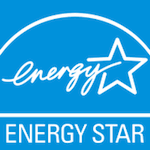The Building Blocks of Green
There are so many ways to "go green" when building or renovating a home. Which have the biggest benefits? Which are the most cost-effective? Which save the most amount of energy for the smallest up-front investment? The Building Blocks of Green can help. We built a Green Wall with these Blocks; the Blocks at the bottom should be considered first. Working up the Green Wall from bottom to top, each layer of Blocks adds green attributes to the home. Follow some of the Block ideas, or follow all of them; any way you choose to use them, the Building Blocks of Green will save energy, reduce environmental impacts, and lower the cost of powering your green home.
The Foundation: Building a Green Wall
The Foundational Blocks form the base of our Green Wall; these are the concepts, ideas, and products that are the easiest to achieve (and can also be among the least expensive.) All buildings need a strong foundation, and our green homes are no exception. Pay attention to the Foundational Blocks before addressing the Blocks higher up on the Green Wall to get the biggest "bang for the buck."
The ideas behind the Foundational Blocks include considering a smaller home, choosing the ideal location for the home, and becoming educated about green design. The Foundational Blocks are HERE.
Next Steps: Climbing the Green Wall
This next layer of Green Building Blocks further energy and water savings in the home and are still relatively easy and affordable to incorporate into the design of any green home. They include reducing air infiltration, reconsidering the lawn, and planning for durability.
Visit the Building Blocks of Green: Next Steps page to learn more.
Layer Three: Further Up the Green Wall
We're up to the third layer of our Green Building Blocks, and the Green Wall is starting to really grow. The ideas and concepts in these first three Block layers have formed a solid foundation for a green home; even if you stop here and don't follow any of the further Building Block concepts, you will have taken steps to make your home much more efficient than a traditional home.
The steps in Layer Three continue to offer excellent energy and money saving ideas, but are starting to cost more and be a bit more difficult to achieve; up-front investment costs are a bit higher, and the turnaround time for recouping investment costs is growing longer. Consider the earlier Blocks first, then take a look at the Layer Three Blocks, which include upgrading insulation and investing in super-efficient heating/cooling systems and windows.
Learn about the ideas behind the third layer of Green Building Blocks HERE.
Higher-Level Building Blocks of Green
Lower Water Usage:
Reducing the amount of water used in and around the home saves money, either by lowering municipal water bills or by reduced pumping. Water sources are being used up faster than nature can replenish them in many areas of the country; luckily, there are many ways to save water around the home.
To learn more about the Water Conservation Building Block, click HERE.
Choosing Efficient Appliances:
Choosing high-efficiency appliances for a green home is a no-brainer; however, the higher up-front costs and longer payback periods put them higher up on the Green Wall.
By researching and choosing very efficient refrigerators, dishwashers, and other household appliances, energy usage can be drastically reduced.
Learn more about saving energy with the Efficient Appliances Building Block by clicking HERE.
Reducing Construction Waste:
The huge amount of waste created by new home construction, even home renovations, tends to get overlooked when thinking about a green home. This is understandable to a certain degree, since construction is a very short part of a homes' life span, and there are no real financial incentives to reducing construction waste.
There is, however, very strong environmental reasons for taking the extra steps necessary to reduce construction waste. Find out about this important Building Block HERE.
Choose Low or No-VOC Paints & Finishes:
Volatile Organic Compounds (VOCs) are the harmful chemical substances found in paints, stains, varnishes, and other finishing products for the home. They're the things that give off that "new paint" smell; they can also contribute to unhealthy indoor air. Exposure to these chemicals can cause asthma and other respiratory problems; reducing or eliminating them is important, and becoming easier all the time with new Low and No-VOC products coming to market that work just as well as their unhealthy counterparts.
Keep your homes' indoor air quality clean and healthy by looking into the Low VOC Building Block HERE.
The Upper Echelon of Green Building Blocks
Green Home Certification:
For homeowners who have made building green a top priority, there are organizations who will certify a home as "green." These third-party certification programs are only for those homes that have used all of the Building Blocks of Green; certification is not easy, nor is it guaranteed.
To learn more about the Green Home Certification Building Block, click HERE.
Push the Green Home Envelope:
Leave the traditional stick-built, frame home behind and 'push the envelope' with a home built using the latest in super-efficient alternative structural systems.
These newer structural systems, like Structural Insulated Panels (SIPs) offer extreme strength, durability, and superior energy-efficiency. These newer systems are not cheap, but offer energy savings of 50% or more compared to traditional framed homes.
Click HERE to learn more about our 'Push the Envelope' Building Block.
The Top of the Wall: Energy Independence!
This is it, the last Block way up here at the top of the Green Wall. If you have followed all of the previous Green Building Blocks, and spent the time and considerable investment in making your home as green as possible, you may be ready for the final step of energy independence. By investing in on-site renewable energy systems like wind or solar, your home can reduce its' carbon and environmental footprint to the extreme; perhaps all the way to zero.
Click HERE to learn about the Final Green Building Block, Achieving Energy Independence.
comments powered by Disqus



































































































































































































